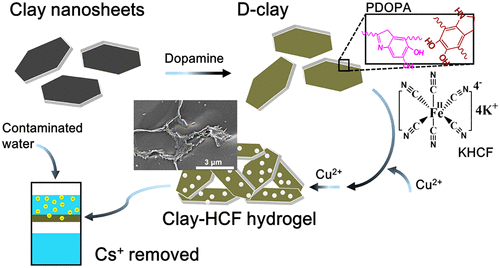当前位置:
X-MOL 学术
›
ACS Appl. Mater. Interfaces
›
论文详情
Our official English website, www.x-mol.net, welcomes your feedback! (Note: you will need to create a separate account there.)
Bio-Inspired Preparation of Clay-Hexacyanoferrate Composite Hydrogels as Super Adsorbents for Cs.
ACS Applied Materials & Interfaces ( IF 9.5 ) Pub Date : 2020-06-12 , DOI: 10.1021/acsami.0c06598 Huagui Zhang 1, 2 , Chris S Hodges 1 , Prashant Kumar Mishra 1 , Ji Young Yoon 3 , Timothy N Hunter 1 , Jae W Lee 3 , David Harbottle 1
ACS Applied Materials & Interfaces ( IF 9.5 ) Pub Date : 2020-06-12 , DOI: 10.1021/acsami.0c06598 Huagui Zhang 1, 2 , Chris S Hodges 1 , Prashant Kumar Mishra 1 , Ji Young Yoon 3 , Timothy N Hunter 1 , Jae W Lee 3 , David Harbottle 1
Affiliation

|
A facile and low-cost fabrication route, inspired by the adhesive proteins secreted by mussels, has been developed to prepare a clay-based composite hydrogel (DHG(Cu)) containing hexacyanoferrate (HCF) nanoparticles for the selective removal of Cs+ from contaminated water. Initially, montmorillonite was exfoliated prior to coating with a thin layer of polydopamine (PDOPA) via the self-polymerization of dopamine. Mixing the composite (D-clay) with the HCF precursor, followed by the addition of copper ions, led to the self-assembly of the polymer-coated exfoliated clay nanosheets into a three-dimensional network and in situ growth of KCuHCF nanoparticles embedded within the gel structure. Analytical characterization verified the fabrication route and KCuHCF immobilization by a copper–ligand complexation. Rheology testing revealed the composite hydrogel to be elastic under low strain and exhibited reversible, self-healing behavior following high strain deformation, providing a good retention of KCuHCF nanoparticles in the membrane. The adsorbent DHG(Cu) showed a superior Cs+ adsorption capacity (∼173 mg/g), with the performance maintained over a wide pH range, and an excellent selectivity for Cs+ when dispersed in seawater at low concentrations of 0.2 ppm. On the basis of its excellent mechanico-chemical properties, the fabricated hydrogel was tested as a membrane in column filtration, showing excellent removal of Cs+ from Milli-Q water and seawater, with the performance only limited by the fluid residence time. For comparison, the study also considered other composite hydrogels, which were fabricated as intermediates of DHG(Cu) or fabricated with Fe3+ as the cross-linker and reactant for HCF nanoparticle synthesis.
中文翻译:

生物启发的粘土-六氰基高铁酸盐复合水凝胶作为Cs的超级吸附剂的制备。
受贻贝分泌的粘附蛋白的启发,开发了一种简便且低成本的制备方法,以制备包含六氰合铁酸盐(HCF)纳米粒子的粘土基复合水凝胶(DHG(Cu)),以选择性去除Cs +来自受污染的水。最初,蒙脱石被剥落,然后通过多巴胺的自聚作用用聚多巴胺(PDOPA)薄层涂覆。将复合材料(D-粘土)与HCF前体混合,然后添加铜离子,导致聚合物涂覆的剥落粘土纳米片材自动组装成三维网络,并原位生长嵌入其中的KCuHCF纳米粒子凝胶结构。分析表征验证了铜-配体络合的制备路径和KCuHCF固定化。流变学测试表明,复合水凝胶在低应变下具有弹性,并在高应变变形后表现出可逆的自愈性能,从而在膜中提供了良好的KCuHCF纳米粒子保留能力。DHG(Cu)吸附剂显示出优异的Cs+吸附容量(约173 mg / g),在很宽的pH范围内都能保持性能,当以0.2 ppm的低浓度分散在海水中时,对Cs +具有极好的选择性。基于其优异的机械化学性能,在柱过滤中将制成的水凝胶作为膜进行了测试,显示出从Milli-Q水和海水中去除Cs +的优异性能,其性能仅受流体停留时间的限制。为了进行比较,研究还考虑了其他复合水凝胶,这些复合水凝胶被制成DHG(Cu)的中间体,或者以Fe 3+作为交联剂和反应物用于HCF纳米粒子合成。
更新日期:2020-07-22
中文翻译:

生物启发的粘土-六氰基高铁酸盐复合水凝胶作为Cs的超级吸附剂的制备。
受贻贝分泌的粘附蛋白的启发,开发了一种简便且低成本的制备方法,以制备包含六氰合铁酸盐(HCF)纳米粒子的粘土基复合水凝胶(DHG(Cu)),以选择性去除Cs +来自受污染的水。最初,蒙脱石被剥落,然后通过多巴胺的自聚作用用聚多巴胺(PDOPA)薄层涂覆。将复合材料(D-粘土)与HCF前体混合,然后添加铜离子,导致聚合物涂覆的剥落粘土纳米片材自动组装成三维网络,并原位生长嵌入其中的KCuHCF纳米粒子凝胶结构。分析表征验证了铜-配体络合的制备路径和KCuHCF固定化。流变学测试表明,复合水凝胶在低应变下具有弹性,并在高应变变形后表现出可逆的自愈性能,从而在膜中提供了良好的KCuHCF纳米粒子保留能力。DHG(Cu)吸附剂显示出优异的Cs+吸附容量(约173 mg / g),在很宽的pH范围内都能保持性能,当以0.2 ppm的低浓度分散在海水中时,对Cs +具有极好的选择性。基于其优异的机械化学性能,在柱过滤中将制成的水凝胶作为膜进行了测试,显示出从Milli-Q水和海水中去除Cs +的优异性能,其性能仅受流体停留时间的限制。为了进行比较,研究还考虑了其他复合水凝胶,这些复合水凝胶被制成DHG(Cu)的中间体,或者以Fe 3+作为交联剂和反应物用于HCF纳米粒子合成。



























 京公网安备 11010802027423号
京公网安备 11010802027423号